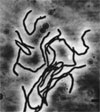Methanobacterium thermoautotrophicum
Другие названия (синонимы):
Methanobacterium thermoalcaliphilum
Methanobacterium thermalcaliphilum
Methanobacterium thermoformicicum
Methanothermobacter thermautotrophicus
Methanobacterium thermalcaliphilum
Methanobacterium thermoformicicum
Methanothermobacter thermautotrophicus
Таксономия
› Сellular organisms (клеточные организмы)
› царство Archaea
› группа Euryarchaeota
› класс Methanobacteria
› порядок Methanobacteriales
› семейство Methanobacteriaceae
› род Methanothermobacter
› вид Methanobacterium thermoformicicum
› царство Archaea
› группа Euryarchaeota
› класс Methanobacteria
› порядок Methanobacteriales
› семейство Methanobacteriaceae
› род Methanothermobacter
› вид Methanobacterium thermoformicicum

Описание археи, среды обитания и особенностей.
Methanobacterium thermoautotrophicum является представителем облигатных термофилов, которые растут при температуре от 40 до 70 градусов Цельсия (оптимальная температура для роста 65 градусов по Цельсию). Для существования данной архее необходим только углекислый газ, водород и соли. Methanobacterium thermoautotrophicum распространена повсеместно в анаэробных условиях и при необходимой температуре ( например, в геотермальных источниках).
Более подробная информация содержится в следующих статьях:
Научные статьи о Methanobacterium thermoautotrophicum.
Complete genome sequence of Methanobacterium thermoautotrophicum deltaH: functional analysis and comparative genomics.
Smith DR, Doucette-Stamm LA, Deloughery C, Lee H, Dubois J, Aldredge T, Bashirzadeh R, Blakely D, Cook R, Gilbert K, Harrison D, Hoang L, Keagle P, Lumm W, Pothier B, Qiu D, Spadafora R, Vicaire R, Wang Y, Wierzbowski J, Gibson R, Jiwani N, Caruso A, Bush D, Reeve JN, et al. Genome Therapeutics Corporation, Collaborative Research Division, Waltham, Massachusetts 02154, USA. doug.smith@genomecorp.com
Abstract
The complete 1,751,377-bp sequence of the genome of the thermophilic archaeon Methanobacterium thermoautotrophicum deltaH has been determined by a whole-genome shotgun sequencing approach. A total of 1,855 open reading frames (ORFs) have been identified that appear to encode polypeptides, 844 (46%) of which have been assigned putative functions based on their similarities to database sequences with assigned functions. A total of 514 (28%) of the ORF-encoded polypeptides are related to sequences with unknown functions, and 496 (27%) have little or no homology to sequences in public databases. Comparisons with Eucarya-, Bacteria-, and Archaea-specific databases reveal that 1,013 of the putative gene products (54%) are most similar to polypeptide sequences described previously for other organisms in the domain Archaea. Comparisons with the Methanococcus jannaschii genome data underline the extensive divergence that has occurred between these two methanogens; only 352 (19%) of M. thermoautotrophicum ORFs encode sequences that are >50% identical to M. jannaschii polypeptides, and there is little conservation in the relative locations of orthologous genes. When the M. thermoautotrophicum ORFs are compared to sequences from only the eucaryal and bacterial domains, 786 (42%) are more similar to bacterial sequences and 241 (13%) are more similar to eucaryal sequences. The bacterial domain-like gene products include the majority of those predicted to be involved in cofactor and small molecule biosyntheses, intermediary metabolism, transport, nitrogen fixation, regulatory functions, and interactions with the environment. Most proteins predicted to be involved in DNA metabolism, transcription, and translation are more similar to eucaryal sequences. Gene structure and organization have features that are typical of the Bacteria, including genes that encode polypeptides closely related to eucaryal proteins. There are 24 polypeptides that could form two-component sensor kinase-response regulator systems and homologs of the bacterial Hsp70-response proteins DnaK and DnaJ, which are notably absent in M. jannaschii. DNA replication initiation and chromosome packaging in M. thermoautotrophicum are predicted to have eucaryal features, based on the presence of two Cdc6 homologs and three histones; however, the presence of an ftsZ gene indicates a bacterial type of cell division initiation. The DNA polymerases include an X-family repair type and an unusual archaeal B type formed by two separate polypeptides. The DNA-dependent RNA polymerase (RNAP) subunits A', A", B', B" and H are encoded in a typical archaeal RNAP operon, although a second A' subunit-encoding gene is present at a remote location. There are two rRNA operons, and 39 tRNA genes are dispersed around the genome, although most of these occur in clusters. Three of the tRNA genes have introns, including the tRNAPro (GGG) gene, which contains a second intron at an unprecedented location. There is no selenocysteinyl-tRNA gene nor evidence for classically organized IS elements, prophages, or plasmids. The genome contains one intein and two extended repeats (3.6 and 8.6 kb) that are members of a family with 18 representatives in the M. jannaschii genome.J Bacteriol. 1997 Nov;179(22):7135-55.
Источник PubMed
www.ncbi.nlm.nih.gov/pubmed
Methanobacterium thermoautotrophicum produces methane from CO2.
Methanobacterium thermoautotrophicum delta H is a methane producing micro-organism (methanogen) that was originally isolated from the municipal waste-treatment facility in Champaign, Illinois, USA. It grows readily and rapidly under laboratory conditions.
In vitro methanogenic extracts and enzymes have been purified and studied for over 20 years. It is an 'absolute' autotroph, requiring only CO2, H2 and salts for growth. It is a representative of the methanogens that inhabit all biodegradation facilities.
DOE (Department of Energy) supports research focused on biochemistry and molecular biology of methane production with the goals of maximising the use of biotechnology to convert waste materials into methane as an alternative to fossil fuels, and determining how to control methane generation and methane release to the atmosphere.
Источник:
www.ebi.ac.uk
Характеристика генома Methanobacterium thermoautotrophicum.
Component name Chromosome
Protein count 1871 1869
Length (bp) 1751377
Av. CDS Length 846.51
GC content 49.5%
CDS coverage 90%
Gene count 1870
Источник: ebi.ac.uk
Полный геном: ncbi.nlm.nih.gov